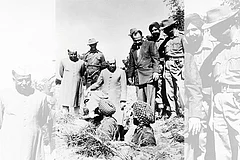A full-blown civil war is raging at the start of Tathagata Bhattacharya’s debut novel. Sands, a coal-rich area of the Republic, has declared itself an independent realm. The Republic is headed by Nida Dodi—an authoritarian far-right religious leader who comes to power with a brute majority. Dodi had contested the elections promising to smash the corporate-politician-bureaucrat nexus, but when she takes office, she shows her true fascist colours. Subsidies to the poor are abruptly cut. Relentless force is unleashed on farmers. All dissent is snuffed out. Opposition leaders are jailed, forced to go underground, or assassinated.
Many stories about Madame President’s bravery are in circulation in the Republic. For instance: “When she was 10, she had swum across a 200-metre-wide river in spate and saved a calf from being washed away. On her way back, she had warded off a crocodile attack…” No one knows for sure if these legends are true, but a large number of people fervently believe in them (and go ahead and vote for her!). Such echoes of the present often permeate the fictional universe of General Firebrand and His Red Atlas, prompting readers to ponder the future of the world we live in where authoritarian leaders run amuck.
Madame President, votary of the survival of the fittest theory and “queen of free-market advocacy”, is in favour of a corporate takeover of land and resources. One day, at a huge public meeting held at a Calcutta suburb, she announces her plans to turn Sands into a Special Economic Zone (SEZ) . The residents of Sands must ‘voluntarily’ surrender their ancestral land and relocate to places they cannot call home. They are given no choice but to sacrifice everything at the altar of progress. When Sands resists, the military marches in. The resistance fighters of Sands manage to escape to the jungles. In about two years, the resistance grows into an organised force: the People’s Resistance Committee (PRC) Guerrillas, “a half-a-million-strong fighting unit”.

Though they are fighting an unequal battle, the resistance has General Firebrand to bolster it. “No retreat, no surrender,” the General chants, exhorting the fighters to carry on. A smart strategist and a soldier who has not let his conscience die; an eccentric; a hater of Party dictates and hierarchies, Firebrand is very popular among the soldiers. However, he is estranged from his wife Laila and son Ryan. His drinking habit and alcohol-induced bouts of violence have ruined his marriage. There are chinks in Firebrand’s revolutionary armour. He pines for his family even when he is guarding Sands’ borders. There are moments when he wishes he could lead a simple life: write a little, grow some flowers, play his ukulele. He is a flawed, human hero, who is “recklessly bold, at times verging on the rash”.
El Commandante and Firebrand, friends for over 30 years, lead Sands’ fight from the front. They are helped by an assortment of characters: some human, some from the animal kingdom, and others, apparitions from the past who despair about the mess that is the present. A few characters from the author’s father Nabarun Bhattacharya’s last unfinished novel also join the cast.
There is a giant black panther, ospreys who attack the enemy and swoop in with timely messages, long-horned birds, convocations of eagles. The beasts of the jungle share battle plans with the resistance fighters. They pick a side and stick to it, determined to ensure the victory of the resistance. Ghosts of famous Soviet generals and snipers (Zaitsev, Pavlichenko, Bagramyan, etc), who fought the Nazis as well as that of WWI Indian ace fighter pilots Indra Lal Roy and Sardar Hardit Singh Malik flit into the narrative. The past is “compelled to step in” because it has valuable insights to offer. Wars against despots have been fought before, and the ghosts come bearing messages about those wars, which the present cannot possibly ignore.
There’s magical realism, mad capers, madcap humour, ghosts from the past, talking animals, strategising birds...
World Island, “the world’s strongest military and economic power” enters the picture. How can a superpower stay away and resist the temptation of taking advantage of this unrest! President Adam Bum of World Island is ready to help Madame President to force Sands to toe the line for strategic reasons. World Island is keen about Sands being turned into a Special Economic Zone and the “factory of the world”. World Island is also prepared to annihilate anyone who stands in the way of its dream of world domination.
The battle that the rebels of Sands are fighting is “about the river turning red, rotting bodies on the banks…about humans braving the dance of death to protect their freedom, about a bullet whizzing past your head, gently whispering into your ears that tomorrow you may not be so lucky.’’
The fight against fascism is a fight to the finish so Bhattacharya throws in every trick in the novelist’s arsenal into the narrative to help Sands along. There’s magical realism and surrealism; a dark dystopia; biting satire; absurdism; mad capers, madcap humour, ghosts from the past, flying saucers, talking animals, strategising birds, startling shifts in time.
Suspending disbelief, going along for the ride with Bhattacharya, and rooting for Sands’ victory in a skillfully built fictional universe is not a tall ask for the reader. But at certain points, the novel suffers from a case of ‘everything, everywhere, all at once’ and rushes ahead at breakneck speed. The battle scenes are etched out expansively, but the emotional arcs of some of the characters don’t get the attention they deserve. Laila and Firebrand’s amicable reunion seems more like a hastily put together plot device than an organic development.
MORE FROM THIS ISSUE
The climax of the novel is a daring feat of imagination. Many disparate elements come together to shape Sands’ future—and the future of the world at large. The magic and madness of the climactic event, the scenes leading up to it, and the birth of a fresh dawn for Sands are well-crafted. They hold out hope to readers of fiction at a time when hope is in short supply in the real world.

































